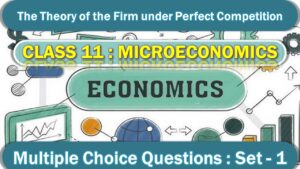CBSE Class 12 Electrostatic Potential and Capacitance Multiple Choice Questions with Answers. MCQ Questions Class 12 Electrostatic Potential and Capacitance with Answers Is Prepared Based on Latest Exam Pattern. Students can solve NCERT Class 12 Electrostatic Potential and Capacitance MCQs with Answers to know their preparation level.
Students who are searching for NCERT MCQ Questions for Class 12 Electrostatic Potential and Capacitance with Answers are compiled here to get good practice on all fundamentals. Know your preparation level on MCQ Questions for Class 12 Electrostatic Potential and Capacitance with Answers. You can also verify your answers from our provided MCQ Class 12 Electrostatic Potential and Capacitance with Answers. So, ace up your preparation with MCQ of Class 12 Physics Examinations.
MCQ Questions Class 12 Electrostatic Potential and Capacitance with Answers - Set - 2
Question 1:
In which of the following forms is the energy stored in a capacitor?
(a) Charge
(b) Potential
(c) Capacitance
(d) Electric field
Correct Answer – (D)
Question 2 :
The capacitance of a capacitor will decrease if we introduce a slab of:
(a) copper
(b) aluminium
(c) zinc
(d) None of these
Correct Answer – (D)
Question 3 :
Which of the following is blocked by a capacitor ?
(a) A.C.
(b) D.C.
(c) Both A.C. and D.C.
(d) Neither A.C. nor D. C
Correct Answer – (B)
Question 4 :
The work done in moving the three charges to infinite separation is:
(a) 180 ergs
(b) 60 ergs
(c) – 60 ergs
(d) (20 + 15 -12) ergs.
Correct Answer – (B)
Question 5 :
The maximum potential upto which the conductor can be charged in Q12 is
(a) 9 × 105 V
(b) 9 × 106 V
(c) 9 × 107 V
(d) 9 × 108 V.
Correct Answer – (B)
MCQ Questions Class 12 Electrostatic Potential and Capacitance with Answers
Question 6 :
Two capacitors of capacitance 6 µF and 4 µF are put in series across a 120 V battery. What is the potential difference across the 4 µF capacitor ?
(a) 72 V
(b) 60 V
(c) 48 V
(d) zero
Correct Answer – (A)
Question 7 :
Two copper spheres of the same radius, one solid and the other hollow, are charged to the same potential. Which will have more charge?
(a) Solid sphere
(b) Hollow sphere
(c) Both will have an equal charge
(d) None of these
Correct Answer – (C)
Question 8 :
The dimensions of fall of potential per unit distance are given by:
(a) [MLT-3 A-1]
(b) [ML2T-2A-1]
(c) [ML2T-2A-3]
(d) [MLT-2A-2]
Correct Answer – (C)
Question 9 :
ABC is a right angled ∆ with AB = 3 cm, BC = 4 cm, AB = 5 cm. Charges of +15 stat. C, -12 and 20 stat Coulomb are placed at A, B, C respectively. The electric potential energy of three charges is:
(a) 180 ergs
(b) 4 × 5 × 3 ergs
(c) – 60 ergs
(d) (20 + 15 – 12) ergs.
Correct Answer – (C)
Question 10 :
The dielectric strength of air at N.T.P. is 3 × 106 V/m. Then the maximum charge that can be given to a spherical conductor of radius 3 m is
(a) 3 × 10-1 C
(b) 3 × 10² V
(c) 3 × 10-3 C
(d) 3 × 10-4 C
Correct Answer – (C)
- NCERT Solutions Class 11 Chemistry Chapter 1 : Some Basic Concepts of Chemistry
- NCERT Solutions Class 11 Chemistry Chapter 2 : Structure Of The Atom
- NCERT Solutions Class 11 Chemistry Chapter 3 : Classification of Elements and Periodicity in Properties
- NCERT Solutions Class 11 Chemistry Chapter 4 : Chemical Bonding and Molecular Structure
- NCERT Solutions Class 11 Chemistry Chapter 5 : States of Matter
- NCERT Solutions Class 11 Chemistry Chapter 6 : Thermodynamics
- NCERT Solutions Class 11 Chemistry Chapter 7 : Equilibrium
- NCERT Solutions Class 11 Chemistry Chapter 8 : Redox Reactions
- NCERT Solutions Class 11 Chemistry Chapter 9 : Hydrogen
- NCERT Solutions Class 11 Chemistry Chapter 10 : The s-Block Elements
- NCERT Solutions Class 11 Chemistry Chapter 11 : The p-Block Elements
- NCERT Solutions Class 11 Chemistry Chapter 12 : Organic Chemistry: Some Basic Principles and Techniques
- NCERT Solutions Class 11 Chemistry Chapter 13 : Hydrocarbons
- NCERT Solutions Class 11 Chemistry Chapter 14 : Environmental Chemistry




